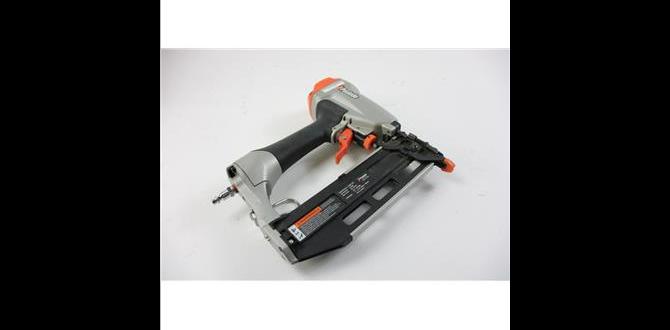The ideal conditions for nail gun storage involve keeping your tools in a dry, climate-controlled environment, free from extreme temperatures and moisture, to prevent rust, corrosion, and damage to internal components. Proper storage ensures your nail gun remains functional and reliable for your next project.
Hello there, fellow DIYer! Jack Shaffer, your friendly neighborhood Nailerguy, is here. Ever finished a project and wondered where to best stash your trusty nail gun? It might seem simple, but where you store your nailer can make a big difference in its lifespan and performance. Leaving it in a damp garage or a scorching hot shed might save you a few minutes now, but it can lead to frustration later. Don’t worry, though! We’re going to walk through exactly how to keep your nail guns in tip-top shape, so they’re ready to help you build those amazing projects whenever inspiration strikes. Let’s dive into the simple secrets of great nail gun storage!
Table of Contents
Why Proper Nail Gun Storage Matters
So, why all the fuss about where you put your nail gun when you’re not using it? Think of your nail gun like any other precision tool – it has working parts that appreciate a stable environment. When you expose your nail gun to harsh conditions, you’re essentially setting it up for trouble.
Here’s a quick look at what can go wrong:
Rust and Corrosion: This is the number one enemy, especially for metal parts. Moisture is a nail gun’s worst nightmare.
Degraded Seals and O-rings: Extreme heat can dry out and crack rubber components, leading to air leaks in pneumatic models or battery issues in cordless ones.
Lubrication Problems: Batteries can lose their charge faster in extreme cold, and lubricants can thicken or become less effective at very low temperatures.
Damage to Electronics: For cordless nail guns, extreme temperatures can permanently damage the battery and internal circuitry.
Reduced Lifespan: Ultimately, poor storage is like running your tool hard without any care – it just won’t last as long.
By understanding and implementing ideal storage practices, you’re not just being tidy; you’re actively investing in the longevity and reliability of your tools. You’ll save yourself time, money, and a whole lot of headaches down the line.
Key Factors for Ideal Nail Gun Storage
Let’s break down the essential environmental factors that contribute to the best storage conditions for your nail guns. These are the pillars of keeping your tools happy and healthy.
1. Temperature Control: The Sweet Spot
Temperature plays a significant role in the health of your nail gun, especially for battery-powered models.
Avoid Extremes: Your goal is to stay away from both freezing temperatures and scorching heat.
Ideal Range: Most manufacturers recommend storing tools and their batteries between 40°F and 80°F (4°C and 27°C). This is a comfortable, moderate range.
Why it Matters:
Cold: Extreme cold can drain batteries quickly, reduce their capacity, and, in very severe cases, permanently damage them. Pneumatic tools can also be affected by condensation freezing inside.
Heat: High temperatures can degrade battery cells, warp plastic components, and damage seals and lubricants. Storing a tool in a hot car or direct sunlight is a recipe for disaster.
Think of it like storing your essential electronics. You wouldn’t leave your smartphone out in the freezing cold or roasting heat, and your nail gun, especially if it’s cordless, deserves similar care.
2. Humidity Levels: Dry is the Way to Go
Moisture is the arch-nemesis of metal tools. High humidity is a silent killer for nail guns.
Keep it Dry: Aim for a low humidity environment. Clammy air is the enemy.
Consequences of Moisture:
Rust: This is the big one. Metal parts inside your nail gun are prone to rusting when exposed to damp air. Rust can impede movement, cause jamming, and weaken components.
Corrosion: Beyond visible rust, moisture can cause chemical corrosion on metal surfaces and electrical contacts and circuit boards in cordless models.
Mold and Mildew: In extreme cases, damp storage can lead to mold and mildew growth, which can affect both the tool and its case.
Best Practices: Store your nail gun in an area that is naturally dry or use dehumidifying methods if necessary.
A little bit of attention to dryness can prevent major headaches and costly repairs down the road.
3. Light Exposure: Out of the Sun’s Glare
While not as critical as temperature or humidity for the mechanics of the tool, direct sunlight can still cause problems.
UV Damage: Prolonged, direct exposure to sunlight can degrade plastics over time, making them brittle and more prone to cracking.
Heat Absorption: Darker colored nail guns or their storage cases can absorb a lot of heat when sitting in direct sun, contributing to the overheating issues mentioned earlier.
Recommendation: Store your nail gun in a shaded area, like inside a cabinet, a toolbox, or the original case it came in, away from windows that receive direct light.
It’s a small detail, but an easy one to manage for overall tool health.
4. Cleanliness: Ready for the Next Job
Before you store your nail gun, a quick clean-up goes a long way in preventing issues.
Remove Debris: Dust, sawdust, and small wood chips can get into the workings of the nail gun. This debris can interfere with smooth operation and even cause jams if significant amounts build up.
Wipe It Down: Use a dry or slightly damp cloth to wipe down the exterior. For pneumatic guns, ensure no water gets into the air intake.
Check for Drips: If you’ve used oil for lubrication (for pneumatic guns), make sure there are no excess drips that could stain or attract dirt.
Importance: A clean tool is less likely to have internal blockages or attract moisture, and it looks and feels more professional, which is always a plus!
A few minutes of cleaning now means your tool is ready and performing at its best when you need it next.
Storage Locations: Where the Magic Happens (or Doesn’t!)
Now that we know the ideal conditions, let’s talk about common places people store their tools and how they stack up. This will help you pick the perfect spot for your nailers.
1. The Workshop/Garage
This is a popular choice for good reason. It’s where you likely do your DIY and woodworking.
Pros:
Convenient: Easy access for projects.
Space: Often has dedicated shelving or tool chests.
Cons:
Temperature Fluctuations: Garages and workshops can often experience significant temperature swings, especially between seasons.
Humidity: These spaces can be prone to dampness, particularly if they aren’t well-sealed or if there’s a water source nearby.
Pests: Can be a haven for various critters.
Tips for Success: If your workshop is your primary storage location, aim to keep it as climate-controlled as possible. Consider a dedicated tool chest, and use desiccant packs (like silica gel) to absorb excess moisture. Ensure good ventilation to prevent stagnant, damp air.
2. The Basement
Basements can be a mixed bag when it comes to tool storage.
Pros:
Stable Temperature: Often cooler in summer and warmer in winter than garages, offering more consistent temperatures.
Out of Sight: Keeps tools protected from casual damage and UV rays.
Cons:
Humidity Issues: Many basements are prone to high humidity and can even experience outright dampness or flooding.
Accessibility: Might be less convenient to retrieve tools if your workshop is elsewhere.
Tips for Success: If your basement is on the damp side, invest in a dehumidifier for the area where you store tools. Concrete floors can wick moisture, so consider keeping toolboxes or shelves off the floor if possible.
3. Indoor Storage (e.g., Closet, Spare Room Shelf)
This is often the best option for maintaining ideal conditions.
Pros:
Climate Controlled: Your home’s interior usually maintains a stable temperature and lower humidity.
Protected: Safe from the elements, pests, and UV damage.
Convenient: If you have a dedicated DIY space indoors or a convenient closet.
Cons:
Space Limitations: Might be harder to find space in already crowded living areas.
Wife/Partner Approval: May require some negotiation depending on your living situation!
Tips for Success: Use the original case or a sturdy toolbox to keep things organized and protected. This is generally the most recommended storage method for maintaining tool longevity.
4. Sheds (Outdoor Structures)
Sheds are convenient but can be very problematic for tool storage.
Pros:
Keeps Tools Away: Frees up space in your garage or home.
Cons:
Extreme Temperatures: Sheds often experience the most extreme temperature fluctuations, being essentially uninsulated outdoor structures.
High Humidity: They can get very damp, especially if not properly sealed or if they are older structures.
Pests: Often a favorite spot for rodents and insects.
Tips for Success: Generally, avoid storing sensitive tools like nail guns in uninsulated sheds. If you absolutely must, ensure it’s a well-sealed, elevated structure, consider a climate-control unit (though this is often impractical for a shed), and use moisture absorbers religiously.
Pneumatic vs. Cordless vs. Electric Nail Gun Storage Concerns
While the core principles of dry, moderate temperature storage apply to all nail guns, there are some specific considerations for different types.
Pneumatic Nail Guns (Air Powered)
These run on compressed air and have fewer sensitive electronics but still have crucial mechanical parts.
Moisture in the Air Lines: The biggest concern is condensation forming inside the compressor tank and air lines that can travel to your nail gun. This is a primary cause of rust.
Lubrication: Pneumatic tools require regular lubrication. Keeping them clean ensures the lubricant works effectively and doesn’t get gummed up with debris.
Specific Storage Advice:
Drain Air Hoses: Always disconnect and drain air hoses after use to remove moisture.
Quick Connectors: Ensure the quick-connect fitting is dry and free of debris before storage.
Lubrication: If your model requires it, apply a few drops of pneumatic tool oil to the air inlet before prolonged storage.
Store Upright: If possible, store them in a way that prevents debris from falling into the air inlet.
Cordless Nail Guns (Battery Powered)
These are the most sensitive to environmental conditions due to their batteries and electronics.
Battery Care is Key: Improper storage is the fastest way to kill a lithium-ion battery.
Temperature Sensitivity: Batteries suffer most from extreme heat (which causes degradation) and extreme cold (which temporarily reduces power and can cause damage if charged while frozen).
Specific Storage Advice:
Battery Health: Store batteries at around 40-60% charge for long-term storage if possible (check your battery manufacturer’s recommendations). Avoid storing them fully charged or completely drained for extended periods, especially in extreme temperatures.
Temperature: Keep the tool and its batteries within the recommended temperature range (ideally 40°F to 80°F / 4°C to 27°C).
Clean Battery Contacts: Ensure the battery terminals and the tool’s contacts are clean to ensure a good connection.
Original Case: Many cordless nailers come with robust cases. Use them! They offer protection and help maintain a more stable internal environment.
Electric (Corded) Nail Guns
These have motors and electronics but no batteries to worry about.
Motor Care: While generally robust, the motor can still be affected by dust and moisture.
Cord Protection: Ensure the power cord is not kinked or damaged during storage.
Specific Storage Advice:
Keep Dry: Moisture can still affect the motor and internal wiring.
Clean Air Vents: Ensure the tool’s air vents are clean and free of debris to allow for proper motor cooling when used.
Cord Management: Coil the power cord neatly without sharp bends.
Your Nail Gun Storage Checklist
To make things super simple, here’s a checklist you can refer to. Before you put your nail gun away, just run through these points.
<table>
<thead>
<tr>
<th>Check Point</th>
<th>Pneumatic?</th>
<th>Cordless?</th>
<th>Electric?</th>
<th>Action Required</th>
</tr>
</thead>
<tbody>
<tr>
<td>Temperature)</td>
<td>✔</td>
<td>✔</td>
<td>✔</td>
<td>Store between 40-80°F (& 27°C). Avoid extremes.</td>
</tr>
<tr>
<td>Humidity</td>
<td>✔</td>
<td>✔</td>
<td>✔</td>
<td>Keep the area very dry. Use desiccants if needed.</td>
</tr>
<tr>
<td>Cleanliness</td>
<td>✔</td>
<td>✔</td>
<td>✔</td>
<td>Wipe down exterior. Remove debris.</td>
</tr>
<tr>
<td>Light Exposure</td>
<td>✔</td>
<td>✔</td>
<td>✔</td>
<td>Store out of direct sunlight.</td>
</tr>
<tr>
<td>Air Line Moisture (Pneumatic)</td>
<td>✔</td>
<td>-</td>
<td>-</td>
<td>Drain hoses and fittings thoroughly.</td>
</tr>
<tr>
<td>Battery Level (Cordless)</td>
<td>-</td>
<td>✔</td>
<td>-</td>
<td>Store at 40-60% charge for long-term.</td>
</tr>
<tr>
<td>Cord Management (Electric)</td>
<td>-</td>
<td>-</td>
<td>✔</td>
<td>Coil loosely, avoid kinks.</td>
</tr>
</tbody>
</table>
Using Desiccants and Moisture Absorbers
For areas where humidity is a persistent problem (like some garages or basements), utilizing desiccants is a smart move.
What are Desiccants? These are materials that attract and hold water molecules, effectively drying out the surrounding air. The most common type you’ll come across is silica gel (those little packets you find in new shoe boxes or electronics packaging).
How to Use Them:
**Small Packets



